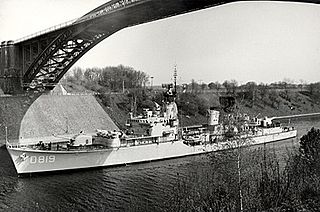Eendracht (the Dutch word for "unity") is a canal and former branch of the river Scheldt in the Netherlands.
Contents
Eendracht or De Eendracht may also refer to:
Eendracht (the Dutch word for "unity") is a canal and former branch of the river Scheldt in the Netherlands.
Eendracht or De Eendracht may also refer to:

Jacob Le Maire was a Dutch mariner who circumnavigated the earth in 1615 and 1616. The strait between Tierra del Fuego and Isla de los Estados was named the Le Maire Strait in his honour, though not without controversy. It was Le Maire himself who proposed to the council aboard Eendracht that the new passage should be called by his name and the council unanimously agreed with Le Maire. The author or authors of The Relation took Eendracht captain Willem Schouten's side by proclaiming:

The Royal Netherlands Navy is the naval force of the Kingdom of the Netherlands.

Dirk Hartog was a 17th-century Dutch sailor and explorer. Dirk Hartog's expedition was the second European group to land in Australia and the first to leave behind an artefact to record his visit, the Hartog Plate. His name is sometimes alternatively spelled Dirck Hartog or Dierick Hartochszch. Ernest Giles referred to him as Theodoric Hartog. The Western Australian island Dirk Hartog Island is named after Hartog.

Dokkum is a Dutch fortified city in the municipality of Noardeast-Fryslân in the province of Friesland. It has 12,669 inhabitants. The fortifications of Dokkum are well preserved and are known as the bolwerken (bulwarks). It is the fifth most popular shopping city in Friesland. It also had the smallest hospital in the Netherlands.

The De Zeven Provinciën class was a class of light cruisers. They were built by Rotterdamsche Droogdok Maatschappij (RDM) and Wilton-Fijenoord for the Royal Netherlands Navy. The name De Zeven Provinciën refers to the seven provinces which formed the Dutch Republic in 1581.
The Eendracht was an early 17th century Dutch wooden-hulled 700 tonne East Indiaman, launched in 1615 in the service of the Dutch East India Company (VOC). Its Dutch name means "concord", "unity" or "union", and was a common name given to Dutch ships of the period, from the motto of the Republic: Concordia res parvae crescunt . The ship was captained by Dirk Hartog when he made the second recorded landfall by a European on Australian soil, in 1616.

BAPAlmirante Grau(CLM-81) is a De Zeven Provinciën-class cruiser that served in the Dutch and Peruvian navies. Completed for the Dutch in 1953 as HNLMS De Ruyter (C801), she was acquired by Peru in 1973 and served as fleet flagship. Almirante Grau underwent a major modernization program between 1985 and 1988 during which she was fitted with new weapons and electronics. She was the last gun cruiser in service in any navy before being decommissioned on 26 September 2017. In 2019, it was to be said that she would be preserved as a museum ship. However, it was later announced on 14 February 2022 that the ship would put up for sale with an asking price of 4,180,000 soles.

Eendrachtsland or Eendraghtsland was derived from the Dutch het Landt van d'Eendracht or Land van de Eendracht and was one of the earliest names given by Europeans to Australia, being in use for 28 years, from 1616 until 1644.
Eight ships of the Royal Netherlands Navy have been named HNLMS De Zeven Provinciën or similar, after the original seven provinces of the Netherlands forming the Union of Utrecht and signing the Act of Abjuration :

The Friesland-class destroyers were built for the Royal Netherlands Navy in the 1950s. They were a larger modified version of the Holland class with more powerful machinery. Eight ships were built. They were replaced by the Kortenaer-class frigates in the early 1980s and seven ships were sold to the Peruvian Navy where they served until 1991. The main armament was supplied by Bofors.
The naval history of the Netherlands dates back to the 15th century. As overseas trade was a traditional cornerstone of the Dutch economy, naval defence was indispensable for the protection of commercial interests.

Leeuwin, was a Dutch galleon that discovered and mapped some of the southwest corner of Australia in March 1622. It was the seventh European ship to sight the continent.
De Hoop is a name used for mills in Belgium and the Netherlands.

De Eendracht is a smock mill in Kimswerd, Friesland, Netherlands which was built in 1872. The mill has been restored to working order. The mill is officially designated as being held in reserve for use in times of emergency. It is listed as a Rijksmonument, number 39358.

The Holland class was a class of six protected cruisers of the Royal Netherlands Navy. The class was built in two groups, each consisting of three ships.

The Mauritius was an early 17th century Dutch wooden-hulled sailing ship, documented as being in service to the Dutch East India Company between 1618 and 1622.
HNLMS Friesland may refer to following ships of the Royal Netherlands Navy:

HNLMS Friesland (D812) was a destroyer of the Friesland class. The ship was in service with the Royal Netherlands Navy from 1956 to 1979. The destroyer was named after the Dutch province of Friesland and was the fourteenth ship with this name. In 1979 the ship was taken out of service and later broken up. The ship's radio call sign was "PAJF".
Anarchism in the Netherlands originated in the second half of the 19th century. Its roots lay in the radical and revolutionary ideologies of the labor movement, in anti-authoritarian socialism, the free thinkers and in numerous associations and organizations striving for a libertarian form of society. During the First World War, individuals and groups of syndicalists and anarchists of various currents worked together for conscientious objection and against government policies. The common resistance was directed against imperialism and militarism.